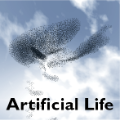A domain-independent problem-solving system based on principles of Artificial Life is introduced. In this system, DIAS, the input and output dimensions of the domain are laid out in a spatial medium. A population of actors, each seeing only part of this medium, solves problems collectively in it. The process is independent of the domain and can be implemented through different kinds of actors. Through a set of experiments on various problem domains, DIAS is shown able to solve problems with different dimensionality and complexity, to require no hyperparameter tuning for new problems, and to exhibit lifelong learning, i.e. adapt rapidly to run-time changes in the problem domain, and do it better than a standard non-collective approach. DIAS therefore demonstrates a role for Alife in building scalable, general, and adaptive problem-solving systems.
翻译:采用一个基于人工生活原则的独立的解决领域问题的系统,在这个系统中,DIAS, 域的投入和产出层面在空间介质中列出; 一组行为者(每个行为者只看到该介质的一部分)共同解决问题; 这一过程独立于领域,可以通过不同类型的行为者实施; 通过对各种问题领域的一系列实验,DIAS证明能够解决不同层面和复杂程度的问题,不需要对新问题进行超分仪调整,并展示终身学习,即迅速适应问题领域的实时变化,并比标准的非集体方法做得更好; 因此,DIAS展示了Ali在建设可扩展、一般和适应的解决问题系统中的作用。




